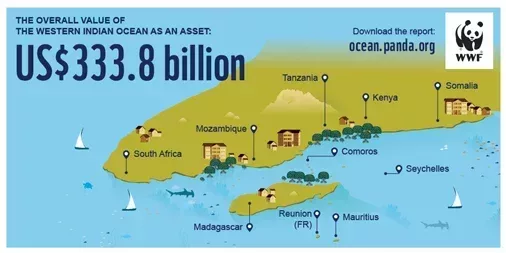Antananarivo, Madagascar – A groundbreaking new report finds the ocean assets of the Western Indian Ocean region are valued conservatively at US$333.8 billion but foreshadows significant challenges for the region’s ocean-based economies and food supplies in the absence of stronger conservation actions.
Reviving the Western Indian Ocean Economy: Actions for a Sustainable Future is the result of an in-depth, joint assessment by The Boston Consulting Group (BCG), CORDIO East Africa and WWF. It combines a new economic analysis of the region’s ocean assets with a review of their contribution to human development.
The report shows that the region’s most valuable assets are fisheries, mangroves, seagrass beds and coral reefs. Adjacent coastal and carbon-absorbing assets are also central to the wellbeing of communities and the health of the ocean economy. The analysis finds that the region is heavily dependent on high-value ocean natural assets that are already showing signs of decline. The report offers a set of priority actions required to secure a sustainable, inclusive ‘blue economy’ for the region, and thus to provide food and livelihoods for growing populations.
Country Director of WWF-Madagascar and Western Indian Ocean Islands, Nanie Ratsifandrihamanana, said, “This analysis shows that the leaders of the Western Indian Ocean face a clear and urgent choice: to continue with business-as-usual, overseeing the steady decline of ocean assets, or to seize the moment to secure the natural ocean assets that will be crucial for the future of fast-growing coastal communities and economies. The Western Indian Ocean still has the chance to get it right.”
Dr. David Obura, lead author of the report and director of CORDIO East Africa, said, “The Western Indian Ocean is still in relatively good condition in global terms, but we now see clear signs of impact from coastal development, local and global demand for the region’s resources, and climate change. Stronger and scaled-up conservation actions – and investment in management – need to be triggered now to avoid diminishing these crucial ocean and coastal assets.”
The report shows that the annual economic output of the region (the equivalent of gross domestic product) is at least US$21 billion, making the ‘ocean economy’ the fourth largest economy in the region in its own right. The most economically-valuable activities on an annual basis in the Western Indian Ocean are coastal and marine tourism, followed by carbon sequestration and fisheries.
BCG Partner and Managing Director, Marty Smits, said, “The Western Indian Ocean is a real test case for how natural ocean assets can be managed sustainably to support growing demands from coastal populations and global pressures. The business case for action is clear: protecting and restoring ocean assets like mangroves, coral reefs and fisheries is a rational approach to future economic prosperity and security.”
John Tanzer, WWF’s Oceans Practice Leader, said, “The Western Indian Ocean must be a central priority for regional and global leaders to successfully implement the UN Sustainable Development Goals and the promise of the Paris climate agreement. Few other places render so starkly how intertwined are the destinies of coastal people and the health of ocean ecosystems. Protecting ocean habitats and managing fisheries sustainably – both small-scale and industrial – are just two areas that will deliver great dividends for years to come.”
“Within the region, the Northern Mozambique Channel initiative provides a good example of the scale of ambition possible for an integrated and sustainable approach to ocean management when decision makers come together around a common vision,” said Mr Tanzer.
Notes to editors:
- The Western Indian Ocean region described in this report includes Comoros, France, Kenya, Madagascar, Mauritius, Mozambique, Seychelles, Somalia, South Africa and Tanzania – a mix of mainland continental and island states. The total population is around 220 million, over a quarter of whom live within 100km of the coast.
- The report also points to the likelihood that much of the actual fishing in the region is for local, domestic consumption via small-scale fishing which is not adequately monitored, or measured in economic terms, so the actual extent of fishing and its importance to local communities is likely to be far greater than economic analyses indicate.
